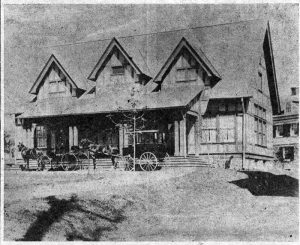
It was on October 17, 1898, that the then current Board of the Saturday Club authorized its president and secretary to sign a contract with J.D. Lengel, of Wayne, for erection of a club house on a lot on West Wayne avenue, purchased from the Wayne Estate.
The report of Mrs. Ralston C. Ware, chairman of the building committee, is still among the club’s most treasured documents. It would seem, as one reads it, as if she were giving the report in person. She tells of the many meetings of the committee with the architect, David Knickerbacker Boyd, a resident of Wayne, who at the turn of the century was one of Philadelphia’s best known architects.
It was with great pride that Mrs. Ware and the two members of her committee made their final report, for in it they stated, “We look forward to our club house as being a rallying place for our members, which will lend a special interest and impetus to all our work, literary and social.” The total cost, including the purchase price of the land, was recorded down to the very penny by Mrs. Ware as $5,145.08!
No additions or alterations of any consequences were made to this original structure until June, 1912, when Mrs. Parke Schock served as chairman of a new building committee, during the presidency of Mrs. Marshall H. Smith. At that time, changes and additions were made in the basement to provide a dining room, as well as the ground floor addition which forms the present stage. It is interesting to know that up to this time, long seats which extended across the east end of the main assembly room unfolded to form a stage.
And how did Wayne itself look in those early days of the Saturday Club’s history? Lancaster avenue was then “Lancaster pike,” a narrow tree-shaded road with toll gate houses at close intervals along it. All vehicles were horse drawn, from the farmer’s wagon to milady’s elegant Victoria with coachman and footman. Bicycling was at its height, with “the ordinary,” as those with the high front wheels were called, just giving away to the “safety,” the forerunner of our modern bicycle. There were hitching posts and livery stables along the pike.
Much of the surrounding countryside was farmland, although by 1886 Wayne was beginning to look like a small town. There was an influx of Philadelphians each June seeking to escape the heat of the city. With their children and nurses, their carriages and coachmen, they led a life of luxurious ease at the beautiful old Bellevue Hotel, on East Lancaster avenue, built in 1881 by George W. Childs, and at the impressive Louella Mansions, built even earlier by one of Wayne’s founders, Henry Askin.
Other buildings already erected by 1886 were the old Opera House, now the Colonial Building; the Wayne Presbyterian Chapel, the original drug store owned by J.M. Fronefleld, on the site of the present Sun Ray store; Leinhardt’s Bakery, the original small building of the First Baptist Church, and the houses on Bloomingdale avenue.
The old Cleaver Farm, by then occupied by the Hughs family, had long been a landmark. The Old Spread Eagle Inn was still standing. The swimming club was located at Kelly’s Dam, in North Wayne, near what is now Willow avenue. A “fire horn,” three feet long, was blown to man the “pumps” when there was a fire. The Radnor Lyceum Hall, where the Saturday Club was founded, was a frame building, then located at the northeast corner of what is now Pembroke and East Lancaster avenues.
